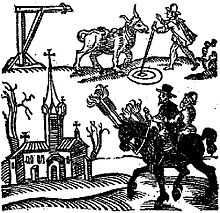North Berwick witch trials

The North Berwick witch trials were the trials in 1590 of a number of people from East Lothian, Scotland, accused of witchcraft in the St Andrew's Auld Kirk in North Berwick. They ran for two years and implicated seventy people. These included Francis Stewart, 5th Earl of Bothwell on charges of high treason. The "witches" held their covens on the Auld Kirk Green, part of the modern-day North Berwick Harbour area. The confessions were extracted by torture in the Old Tolbooth, Edinburgh.
History
This was the first major witchcraft persecution in Scotland, and began with a sensational case involving the royal houses of Denmark and Scotland. King James VI sailed to Copenhagen to marry Princess Anne, sister of Christian IV, King of Denmark. During their return to Scotland they experienced terrible storms and had to shelter in Norway for several weeks before continuing. The admiral of the escorting Danish fleet blamed the storm on the wife of a high official in Copenhagen whom he had insulted. Several nobles of the Scottish court were implicated, and witchcraft trials were held in Denmark.[1] One of the first Danish victims was Anna Koldings, who, under pressure, divulged the names of five other women; one of whom was Mail the wife of the burgomaster of Copenhagen. They all confessed that they had been guilty of sorcery in raising storms that menaced Queen Anne's voyage, and that they had sent devils to climb up the keel of her ship. In September two women were burnt as witches at Kronborg" [2] James heard news from Denmark regarding this and decided to set up his own tribunal.
Gillis Duncan
Scottish witches were linked to storms when a maid named Gillis Duncan, who worked for a man named David Seaton in the town of Tranent, was forced into a confession by her employer. Apparently Duncan suddenly began to exhibit a miraculous healing ability and would sneak out of the house during the night. When Seaton confronted Duncan and she could not explain her new ability and strange behaviour, he had her tortured. Under torture, she confessed to being a witch and accused many others of witchcraft. According to the contemporary pamphlet Newes from Scotland, 1591, she named numerous individuals, both women and men:
Agnes Sampson the eldest witche of them all, dwelling in Haddington; Agnes Tompson of Edenbrough; Doctor Fian alias John Cuningham, master of the schoole at Saltpans in Lowthian, of whose life and strange acts you shal heare more largely in the end of this discourse. These were by the saide Geillis Duncane accused, as also George Motts wife, dwelling in Lowthian; Robert Grierson, skipper; and Jannet Blandilands; with the potter's wife of Seaton: the smith at the Brigge Hallis, with innumerable others in those parts, and dwelling in those bounds aforesaid; of whom some are alreadie executed, the rest remaine in prison to receive the doome of judgment at the Kinges Majesties will and pleasure.[3]
Accused

Very soon more than a hundred suspected witches in North Berwick were arrested, and many confessed under torture to having met with the Devil in the church at night, and devoted themselves to doing evil, including poisoning the King and other members of his household, and attempting to sink the King's ship.[1]
The two most significant accused persons were Agnes Sampson, a respected and elderly woman from Humbie, and Dr. John Fian a schoolmaster and scholar in Prestonpans. Both refused to confess, but were put to severe torture. Sampson was brought before King James and a council of nobles. She denied all the charges, but after being tortured horrifically, she finally confessed. She was fastened to the wall of her cell by a witch's bridle, an iron instrument with 4 sharp prongs forced into the mouth, so that two prongs pressed against the tongue, and the two others against the cheeks. She was kept without sleep, thrown with a rope around her head, and only after these ordeals did Agnes Sampson confess to the fifty-three indictments against her. She was finally strangled and burned as a witch. According to Newes from Scotland, Declaring the Damnable Life of Dr. Fian, a Notable Sorcerer, a pamphlet published in 1591, Sampson confessed to attending a Sabbat with 200 witches, Duncan among them.[4][5]
Dr. Fian also suffered severe torture. He endured having his fingernails forcibly extracted, then having iron pins thrust therein, the Pilliwinks, and The Boot. He was finally taken to the Castlehill in Edinburgh and burnt at the stake on 16 December.
According to T. C. Smout, between 3,000 and 4,000 accused witches may have been killed in Scotland in the years 1560–1707.[6]
Popular culture
Heavy/doom metal group Cathedral have a song called "North Berwick Witch Trials" on their 2005 album The Garden of Unearthly Delights.
See also
- Newes from Scotland
- North Berwick
- Scots law
- Scottish folklore
References
- ↑ 1.0 1.1 Ankarloo, B., Clark, S. & Monter, E. W. Witchcraft and Magic in Europe. p. 79
- ↑ Anne of Denmark, Ethel Carleton Williams. Longman, 1970.
- ↑ Newes from Scotland, 1591, as reprinted in Pitcairn's Criminal Trials in Scotland, vol. 1, pt. 2, pp. 215-223.
- ↑ Rosen, Barbara (1969). Witchcraft in England, 1558–1618. Univ of Massachusetts Press.
- ↑ Guiley, Rosemary (2008). The Encyclopedia of Witches, Witchcraft and Wicca. Infobase.
- ↑ Smout 1969, pp. 184–92.
Bibliography
- Smout, Thomas Christopher (1969), A History of the Scottish People 1560–1830, pp. 198–207.
External links
- "13", Memoirs of Popular Delusions 2, World wide school.
- Thompson, Edward H, Analysis of "Newes from Scotland", Tesco.